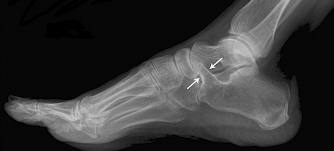Tarsal Coalition
A tarsal coalition is an abnormal connection of two or more bones in the foot. Tarsal coalition develops when the bones grow into one another connected by a bridge of bone, cartilage, or fibrous tissue. The bridge can cover a small amount of the joint space or a larger portion of the space.
This condition is typically caused by a genetic mutation that can affect the cells that develop the tarsal bones, causing the malformity in the bones. Individuals who have this condition ordinarily have had the ailment before birth. Although the coalition forms before birth, its presence if often not noted until a child is of school age or adolescence. It is estimated that one out of every 100 people may have a tarsal coalition and can typically affect both feet.
The two most affected locations of tarsal coalition are between the calcaneus and navicular bones, or between the talus and calcaneus bones. However, other joints can also be affected by this condition.
The exact incidence of the disorder is difficult to establish because many coalitions never cause noticeable symptoms. However for patients who do develop symptoms can include the following; stiff and painful feet which can occur below the ankle near the middle or back of the foot, difficulty walking on flat surfaces or recurrent sprained ankles.
To accurately diagnose the malformity, your physician can order a variety of images ( X-rays or CT scans) to help confirm the diagnosis. Once confirmed treatment options can be discussed with you doctor. Some treatment options that can be discussed with you physician can range from non surgical treatments to surgical interventions to help aid the symptoms caused by tarsal coalition.
Non surgical treatments can include the following: rest from high impact activities, orthotics arch supports or steroid injections. If all nonsurgical treatment have not been effective surgical intervention can be considered to help relieve symptoms. Surgical alternatives involve resecting the anomaly and providing a more normal range of motion to the joint. Sometimes, this procedure may not be a correct choice. In that scenario, the surgeon might choose to fuse this joint. If a joint is fused the recovery might be longer and the patient might not able to bare weight for a longer period. A patient needs to go to physical therapy after surgery to speed up the recovery and increase the range of motion.

.png)
.png)













